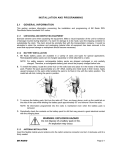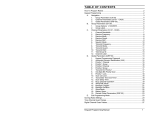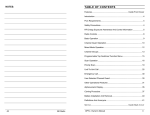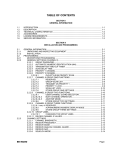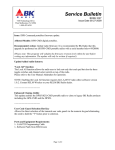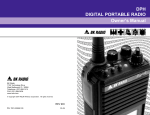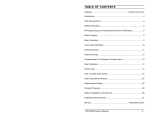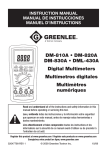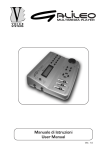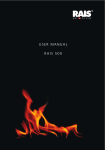Download "user manual"
Transcript
Contents How to Program Radios ...................................................................... 3 Keypad Programming ......................................................................... 3 General Settings (Channel 0) ............................................................. 4 Group Password ............................................................................5 Automatic Numeric Identification (ANI) ..........................................6 Transmitter Time-Out Timer ...........................................................6 Scan Delay Time ............................................................................7 Priority 1 Channel ..........................................................................7 Priority 2 Channel ..........................................................................8 Channel 0 Group One Functions ...................................................8 Battery Saver Inhibit ...................................................................9 Group Scan List .........................................................................9 Transmit On Priority 1 ................................................................9 Priority 1 Lock ............................................................................9 Scan List Lock ..........................................................................10 Channel 0 Group Two Functions ..................................................10 User Code Guard Selection .....................................................10 Busy Channel Operation ..........................................................11 ANI/DTMF Mode ......................................................................11 Channel 0 Group Three Functions ...............................................12 Backlight On Display Change ..................................................12 Backlight On Key Press............................................................13 Alphanumeric/Numeric Display Mode ......................................13 Backlight Duration ........................................................................13 Group Labels................................................................................14 Review Channel 0 Values ........................................................15 RELM/BK Radio 1 Channel Settings ............................................................................... 15 Channel Bandwidth ......................................................................15 Receive Frequency ......................................................................16 Receive Mode ..............................................................................16 Receive Analog Code Guard .......................................................16 Receive NAC ................................................................................17 Squelch Mode ..............................................................................17 Transmit Frequency ......................................................................18 Transmit Mode..............................................................................18 Transmit Analog Code Guard.......................................................19 Transmit NAC ...............................................................................20 Talk Group ID ...............................................................................20 Secure Selection (Encrypted Radios Only)..................................20 Encryption Key (Encrypted Radios Only) .....................................21 Key Selection Setting (Encrypted Radios Only) ...........................22 Channel Label ..............................................................................22 Review Channel Settings .............................................................22 Program Another Channel ...........................................................23 Exit Programming Mode ..............................................................23 Cloning Radio Settings ..................................................................... 23 Special Cloning Instructions.........................................................25 Scan List Cloning .........................................................................26 CTCSS Code Guard Values .............................................................. 27 CDCSS Code Guard Values .............................................................. 28 Quick reference Guide - Channel 0 .................................................. 29 2 DPHx Programming Manual How to Program Radios There are three different ways to program BK Radio radios: • BY KEYPAD A radio can be programmed with its keypad and a programming plug, LAA0701. That procedure is described in this section. • BY CLONING You can transfer the programmed settings to another radio of the same frequency band by using a cloning cable. See "Cloning Radio Settings" on page 23 of this manual. • BY COMPUTER With a computer, DPHx programming software, and an LAA 0725 interface cable. That procedure is not described in this manual. Contact BK Radio for the required programming cable and software. Keypad Programming Radios are shipped with a door covering the keypad and display. Before programming, remove the door by removing the battery pack, engaging the door just below the speaker grill, and sliding the door downward. Replace the battery pack. Make sure the battery pack is charged. Master Switch Digital ch 01 Programming Plug -- -- id RELM/BK Radio 1. Insert the programming plug into the side connector of the radio. The push-button master switch will be on the top. NOTE: The cloning cable can be used as a substitute for the programming plug by inserting the end with the push-button master switch into the side connector of the radio. 2. Select a channel group to be programmed See "Select A Group/Channel” in the Owner’s Manual. 3. Press and hold the master switch. 4. While holding the master switch, press and hold the [FCN] key. After approximately three seconds the LCD will display ‘- - - ID.’ 3 5. Release the [FCN] key and the master switch. The radio is now in the Password Entry Mode. 6. Enter the six-digit password code for the selected group. Without the correct password code, you cannot proceed with programming. NOTE: New radios shipped from the factory are assigned the password code 000000. While entering the password code the display will not change, but a beep will sound for each key pressed. If the password code is entered incorrectly, the radio will reset to normal operation. Try again, starting at step 2. PRG CH 00 7. Press the [ENT] key to proceed to Programming Mode. The display will change to PRG CH 00. NOTE: Your radio may have been programmed to block keypad programming access to some or all variables. Contact your BK Radio Dealer if you need access to these fields. GENERAL SETTINGS (CHANNEL 0) Channel 0 settings for each group must be programmed separately. NOTE: Settings listed as Group One Functions, Group Two Functions, and Group Three Functions refer to programming function groups, not channel groups. Press the [FCN] key repeatedly to view the settings in Channel 0 and then loop back to the CH 00 entry point. QUICK REFERENCE GUIDE - CHANNEL 0 RADIO KEYPAD PROGRAMMING Group Password Automatic Numeric Identification (ANI) Transmitter Time-Out Timer Scan Delay Time Priority 1 Channel Priority 2 Channel Channel 0 Group One Functions Battery Saver Inhibit Group Scan List Transmit On Priority 1 Priority 1 Lock Scan List Lock Channel 0 Group Two Functions User Code Guard Selection Busy Channel Operation ANI/DTMF Mode 1-12345 1-12345 1-12345 1-12345 1-12345 2-12345 2-12345 2-12345 Channel 0 Group Three Functions Reserved for Future Enhancements Backlight on Display Change Backlight on Key Press Alphanumeric/Numeric Display Mode 3-12345 3-12345 3-12345 3-12345 Backlight Duration Group Label Channel 0 settings include: Group Password Flashing number indicates active function. Automatic Numeric Identification (ANI) Transmitter Time-Out Timer Scan Delay Time 4 DPHx Programming Manual RELM/BK Radio 29 Priority 1 Channel CDCSS CODE GUARD VALUES Priority 2 Channel Channel 0 Group One Functions: 1-12345 Codes for the CDCSS Code Guard system may be chosen fr om the following list. Since there are no EIA standards for the performance or compatibility of CDCSS Code Guard systems it is recommended that an operational test be made on the intended system before wholesale assignments are made. In some cases either or both transmit and receive codes will require an inverted code to operate with existing systems. This can be done during the code programming of the system. Usually systems using direct Unit-to-Unit transmission (systems without mobile relays, repeaters, remote control, etc.) may use codes from the table. Systems with relays, etc., may use code variations for systems control and operational efficiency. The system operator or engineer should be consulted regarding the operational requirement on such systems. Battery Saver Inhibit (Function 1) Group Scan List (Function 2) Transmit on Priority 1 (Function 3) Priority 1 Lock (Function 4) Scan List Lock (Function 5) Channel 0 Group Two Functions: 2-12345 User Code Guard Selection (Function 1) Busy Channel Operation (Functions 2 & 3) ANI/DTMF Mode (Functions 4 & 5) Channel 0 Group Three Functions: 3-12345 023 065 131 165 245 315 411 466 612 703 025 071 132 172 251 331 412 503 624 712 Reserved (Functions 1 & 2) 026 072 134 174 261 343 423 506 627 723 Backlight on Display Change (Function 3) 031 073 143 205 263 346 431 516 631 731 Backlight on Key Press (Function 4) 032 074 152 223 265 351 432 532 632 732 043 114 155 226 271 364 445 546 654 734 Alphanumeric/Numeric Display Mode (Function 5) 047 115 156 243 306 365 464 565 662 743 051 116 162 244 311 371 465 606 664 754 054 125 Backlight Duration Group Label Group Password PRG ch 00 PRG p 123456 1. After entering Programming Mode the display will show ‘PRG CH 00.’ 2. Press the [FCN] key. 3. The display will indicate the password for the selected group. 4a. If no change is needed for the group password, press the [FCN] key to advance to the next field. 4b. To enter a new password, press the [CLR] key, then enter a new six-digit password. Press the [ENT] key to store the new password and advance to the next field. 28 DPHx Programming Manual RELM/BK Radio 5 Automatic Numeric Identification (ANI) PRG ID 0000000 1. After the group password is set, the display will indicate the ANI ID number (as many as seven digits may be used). The ID number can be used for either radio management or transmitted as a DTMF tone burst for ANI purposes. The ANI can be enabled or disabled. See “ANI/DTMF Mode” on page 11 of this manual. 2a. If no change is needed for the ID number, press the [FCN] key to advance to the next field. 2b. To enter a new number, press the [CLR] key and then the number keys. The digits will appear at the right of display and move to the left. Press the [ENT] key to store the new ID number and advance to the next field. Transmitter Time-Out Timer CTCSS CODE GUARD VALUES The CTCSS Code Guard system may be set for any frequency in the range of 67 to 255.9 Hz. However, since most systems adhere to the Electronic Industry Association (EIA) standards, tones should be selected from the following EIA list. In order to insure optimum performance, tone selection for use on the same radio frequency (RF) channel or adjacent channels in the same coverage area should be made from one of the Groups A, B, or C to the maximum degree possible. Group A Group B 67.0 (XZ) *151.4 (5Z) 77.0 (XB) 162.2 (5B) 88.5 (YB) 173.8 (6A) *100.0 (1Z) 186.2 (7Z) 71.9 (XA) Group C 146.2 (4B) 74.4 82.5 (YZ) 156.7 (5A) 79.7 94.8 (ZA) 167.9 (6Z) 85.4 (YA) 103.5 (1A) *179.9 (6B) 91.5 (ZZ) 107.2 (1B) 203.5 (M1) 110.9 (2X) 192.8 (7A) After the ID number is set, the display annunciators will indicate ‘PRG TX.’ This is the duration of the transmitter Time-Out Timer. 0 SEC means the Time-Out Timer is disabled. 114.8 (2A) 218.1 (M3) *118.8 (2B) 210.7 (M2) Press the [FCN] key to advance to the next field if no change is needed. 141.3 (4A) PRG TX 225 sec 1. Press the [PRI] key to increase the Time-Out Timer duration by 15 seconds, with a maximum of 225 seconds (3 minutes, 45 seconds). Press the [PRI] key again to change the duration from 225 seconds to zero. 123.0 (3Z) 233.6 127.3 (3A) 225.7 (M4) 131.8 (3B) 250.3 136.5 (4Z) 241.8 * 50/60 Hz power distribution systems could cause falsing. The assignments in a given area shall be made from within one of the Groups: A, B, or C. 2. Press the [CLR] key to set the Time-Out Timer duration to zero. 3. Press the [ENT] key to store the changed setting and advance to the next field. 6 DPHx Programming Manual RELM/BK Radio 27 NOTE: Any new number can be entered at this point by pressing the [CLR] key and using the digit keys to enter the new number. PRG clone 7. Press the [*] key. Connect the cable to the second Clone and download by pressing [FCN]. 8. Any number of radios can be coded with different or sequential ID numbers using this technique. The ID number in the permanent memory of the Master radio will remain unchanged as 100. Scan Delay Time After the Time-Out Timer is set, the upper display will indicate ‘PRG SCN.’ This is the Scan Delay time in seconds. Press the [FCN] key to advance to the next field if no change is needed. PRG SCN 2.0 SEC 2. Press the [CLR] key to reset the scan delay time to 0. Scan List Cloning When a Master radio downloads to a Clone, the Scan List is also transferred. See the appropriate operating instructions in the Owner’s Manual for changing the Scan List. 1. Press the [PRI] key to increase the scan delay time by .5 seconds, up to 7.5 seconds. Press the [PRI] key again to change the time from 7.5 seconds to 0. 3. Press the [ENT] key to store the changed setting and advance to the next field. Priority 1 Channel After the Scan Delay is set, the display will indicate ‘PRG PR1.’ The Priority 1 Channel can be programmed as a fixed channel, tied to the Channel Selector knob, or programmed OFF. If the radio is programmed to transmit on the Priority 1 Channel, transmissions will occur on PR1, if PR1 isn’t programmed OFF, when operating in Single or Dual Priority Scan Mode. If PR1 is a fixed channel, and the [PRI] key on the keypad is not locked out, during normal radio operation the user can move the channel selector to a new channel and press the [PRI] key to choose a new PR1 channel. PRG PR 1 ON 1. Press the [PRI] key to cycle through the priority channel options, or enter a fixed priority channel using the number keys. Setting the channel to ON ties the PR1 channel to the Channel Selector knob. Pressing [CLR] or the [0] key turns the PR1 channel OFF. 2. Press the [ENT] key to store the new priority channel and advance to the next field. 26 DPHx Programming Manual RELM/BK Radio 7 Priority 2 Channel NOTE: To stop the ‘FAIL’ Mode, press [CLR], turn off both radios, and try again, starting with Step 1 on the previous page. After the Priority 1 Channel is set, the display will indicate ‘PRG PR2.’ The Priority 2 Channel can be programmed as a fixed channel, tied to the Channel Selector knob, or programmed OFF. The PR2 channel cannot be altered during normal radio operation. PRG PR 2 OFF Special Cloning Instructions 1. Press the [PRI] key to cycle through the priority channel options, or enter a fixed priority channel using the number keys. It is possible to change Channel 0 values on the Master radio, hold them in a temporary memory, and download them to the Clone without actually entering them into the permanent memory of the Master radio. This is convenient for sequential identification numbers used to identify a series of portables in a radio system. Setting the channel to ON ties the PR2 channel to the Channel Selector knob. Pressing [CLR] or the [0] key turns the PR2 channel OFF. 2. Press the [ENT] key to store the new priority channel and advance to the next field. Assuming that the frequencies, Code Guard values, and other CH 0 values are common for all radios in the system, but that the radio identification number should be unique to each radio, the following method would be used to clone additional radios for the system. Old-Style BK Priority Scan The radio can be programmed to mimic the Old-Style BK Priority Scan Modes as follows: Mode PR1 TX on PR1 PR2 A On No Off B Fixed Channel # No Off C Fixed Channel # Yes Off See “Priority Scan” in the Owner’s Manual for operational details of the Old-Style BK Priority Scan Modes. 1. Program the Master radio with all frequencies, Code Guard values, and Channel 0 values that will be common to all radios to be cloned. 2. Advance the display to show the Master radio's ID number - for example, 100. PRG ID 125 Channel 0 Group One Functions PRG 1 -- 12345 After the Priority 2 Channel is set the display will show ‘PRG 1-12345.’ This is a group of five individual functions that can be enabled or disabled. When a function is enabled, the corresponding number in the display will flash. When the function is disabled the number is steady. If you wish to change the function from enable to disable or vice versa, press the number key corresponding to that function. 8 DPHx Programming Manual 3. Press the [CLR] key; press 125. Do not press the [ENT] key. Now 125 is in temporary memory. 4. Press the [*] key, connect the cable to the radios and download to the Clone by pressing the [FCN] key. ID number 125 is now stored in permanent memory of the Clone. 5. After download, press the [CLR] key on the Master radio. Disconnect the Clone. The Master radio display will show that 125 is still being held in the temporary memory of the Master radio. PRG ID 126 RELM/BK Radio 6. Press the [PRI] key. This will increment the ID number one digit to 126. 25 PRG ch 00 5. Put the Master radio in Programming Mode by pressing and holding the master switch then pressing and holding the [FCN] key until the display shows ‘- - - ID.’ Enter the password of the selected group. The display shows ‘PRG CH 00.’ 6. Review the values programmed in the radio by pressing the [FCN] or [ENT] key at each CHXX prompt. Any required changes must be made now. 7. Connect the other plug of the cable to the side connector of the radio you want to clone. PRG 1 -- 12345 1. Battery Saver Inhibit PRG 1 -- 12345 8. Turn on the clone and set it to the desired channel group. PRG prog PRG clone 9. Press the [*] key on the Master radio keypad. The display will flash ‘PROG’ signifying that the radio is ready to download its program to the clone. 10. Press the [FCN] key on the Master radio keypad. The display will flash 'CLONE' while information from the master is downloaded to the clone. 11. If the download was successful, the display on the master will resume flashing ‘PROG.’ • To clone another channel group, turn off both radios and go back to Step 3, changing the channel group as required. fail 12. If the download was not successful, the master will display ‘FAIL’ and multiple beeps will follow. Failure of downloading can be due to: • Improper connection 2. Group Scan List PRG 1 -- 12345 PRG 1 -- 12345 When function 3 is enabled (flashing) transmissions will occur on PR1, if PR1 isn’t programmed OFF, when operating in Single or Dual Priority Scan Mode. To simulate BK Radio’s Old-Style Priority Mode C, Transmit on Priority 1 must be enabled, with Priority 2 channel set to OFF. 4. Priority 1 Lock PRG 1 -- 12345 When function 4 is enabled (flashing) the [PRI] key is locked out in the Operating Mode. The user will not be able to change the designation of the Priority 1 Channel. When function 4 is disabled (steady) the user will be able to change the channel that is designated as Priority 1 Channel. See “Dual Priority Scan” in the Owner’s Manual. • Setting the clone in Programming Mode • Group ‘locked’ by PC Programming DPHx Programming Manual When function 2 is enabled (flashing) the current group will be scanned when the radio is operating in Group Scan Mode. 3. Transmit On Priority 1 • Failure to turn on the clone 24 When function 1 is enabled (flashing) the battery saver is turned off. The battery saver should be turned off only for getting proper voltage readings during service or for systems requiring fast squelch attack time. NOTE: BK Radio current drain and battery life specifications are based on performance with the battery saver on. • If cloning is finished, turn off the clone and disconnect the cloning cable. Normal radio operation will occur when you turn on the clone. PRG EXAMPLE: If function 4 (Priority 1 Lock) is disabled, the 4 in the display will not be flashing. If the [4] key is pressed, the 4 in the display will flash, signifying that Priority 1 Lock is enabled. A subsequent press of the [4] key will disable Priority 1 Lock. RELM/BK Radio 9 Program Another Channel 5. Scan List Lock PRG 1 -- 12345 When function 5 is enabled (flashing), the user will not be able to change the channels in the Scan List. When disabled (steady), the user can enter or delete channels from the Scan List. See “Change the Scan List” in the Owner’s Manual. Store Group One Settings Once each function 1-5 is set as desired, you can store the changes, discard the changes, or disable all 5 functions. At the starting point for Channel 1, the display will show ‘PRG CH 01’. Press the number keys for another channel number to gain access to the frequencies, etc. for that channel. Each channel is then programmed using the same steps described for Channel 1. PRG ch 01 Exit Programming Mode CG-SQ Once each function 1-5 is set as desired, you can store the changes, discard the changes, or disable all 5 functions. A B Press the [CLR] key to disable all Group One functions (steady). C OFF-VOL 6 5 4 3 7 8 9 10 11 12 13 14 2 15 1 16 1. Rotate the OFF-VOL knob counterclockwise to the OFF position. 2. The radio will be in normal Operating Mode the next time it is turned on. Press the [ENT] key to store new Group One settings into memory and advance to the next field. Press the [FCN] key to advance to the next field without saving changes. Channel 0 Group Two Functions PRG 2-- 12345 After Group One functions are set, the display will show ‘PRG 2-12345’ for Group Two functions. As with Group One functions, the enabled function numbers will flash. The disabled functions remain steady 1. User Code Guard Selection PRG 2-- 12345 When function 1 is enabled (flashing) the user will be able to press the keypad to independently select the Code Guard values that are programmed into Channels 1 through 16 while operating on any Channel 1 through 16. When function 1 is disabled the user will be unable to use the keypad for Code Guard selection. See "User Selected Code Guard" in Owner’s Manual. CLONING RADIO SETTINGS Any “Master” radio (a DPHx with the desired radio frequencies and settings) is capable of transferring its program to another DPHx or “slave” radio. The radio receiving the program is referred to as the “clone.” The LAA0700 or E/GCC cloning cable will be required in the following procedure. Contact your BK Radio dealer for information on cloning between DPHx radios and other BK Radio products. NOTE: Some groups may be “locked” by PC programming to prevent them from being overwritten. Only “unlocked” groups will accept incoming clones. Master Clone Digital Digital SCN D CMND ch 01 RX MHCMD PROG|D 01 GROUP PRG TX RX SCN D CMND ANNEL HOME CH ch 01 PRG TX Master Switch 1. Make sure the battery packs for both radios are charged. 2. Attach the master switch end of the cloning cable to the side connector of the Master radio. NOTE: One plug of the cloning cable has a push-button master switch. This plug must be attached to the Master radio. 3. Turn on the Master radio. 4. Select the group to be cloned from the Master radio. 10 DPHx Programming Manual RELM/BK Radio 23 Key Selection Setting (Encrypted Radios Only) PRG TX ID key -- xxx In radios equipped with DES/AES encryption, the next field is the Encryption Key Selection setting. This selection will not appear in radios that do not have the encryption option. The upper line of the display will show ‘PRG TX ID’, and the lower part of the display will show ‘KEY-XXX’, where XXX can be ‘SEL’, for selectable or 'LCK', for locked. 2 & 3. Busy Channel Operation PRG 2-- 12345 Busy Channel Modes include: Busy Channel Indicator - The yellow LED illuminates when a signal is received on the channel selected, with or without the programmed receive Code Guard setting. If the selection is set to Selectable, the encryption key can be selected via the radio's keypad. If the selection is set to Locked, this channel will always use the encryption key selected in the previous setting. Busy Channel Lockout - The yellow LED illuminates and the transmitter PTT is disabled when a signal is received without the programmed receive Code Guard setting. For information on selectable key operation refer to your radio's owner/user manual. Busy Channel Override - This function is similar to Busy Channel Lockout except the transmitter PTT can be activated by rotating the Squelch knob clockwise off the Code Guard detent. 1. If this setting is correct, press the [FCN] key to advance to the next field. 2. If a new mode is desired, press the [PRI] key to cycle through the mode settings. Press [ENT] to store the new mode and automatically advance to the next field. To set Busy Channel operation, use the following chart: Channel Label PRG LABEL The last field is the channel label. 1. If this label is correct, press the [FCN] key to proceed to the entry point. 2. If a new channel label is desired, follow the instructions under "Group Labels" on page 14 of this manual. Review Channel Settings Busy Channel Function 2 Function 3 Indication Disable (Steady) Enable (Flashing) Lockout Enable (Flashing) Enable (Flashing) Override Enable (Flashing) Disable (Steady) 4 & 5. ANI/DTMF Mode PRG 2-- 12345 After the channel label is set, the display will return to the Channel 1 starting point. If you wish to review the Channel 1 settings, subsequent pressing of the [FCN] or [ENT] key will show each value and then return to the Channel 1 starting point. 22 DPHx Programming Manual Functions two and three are used to set Busy Channel operation. There are three types of busy channel operation available. They are described more fully under "Busy Channel" in the Owner’s Manual. When function 4 is enabled (flashing) the ANI ID number will be transmitted (as a DTMF tone sequence) with each press of the PTT switch. See "Automatic Numeric Identification (ANI)" on page 6 of this manual for instructions on setting the ANI number. When function 5 is enabled (flashing) the keypad becomes active for manual DTMF operation. When functions 4 and 5 are both enabled (flashing) the ANI tone sequence will be transmitted only after the [ENT] key is pressed while the transmit RELM/BK Radio 11 PTT switch is activated. A sidetone of the ANI number transmitted will also be heard through the speaker. show ‘SEC-XXX’, where XXX can be ‘CLR’ to always transmit a clear signal, ‘ENC’ to always transmit an encrypted signal or 'SW' where the tranmission can be selected via a programmed switch. Store Group Two Settings NOTE: To use the 'SW' selection one of the radios toggle switches or [FCN] menu selection must be programmed with for the 'Transmit Secure' selection. These settings require the use of the PC Radio Editor LAA0744X. Once each function 1-5 is set as desired, you can store the changes, discard the changes, or disable all 5 functions. Press the [CLR] key to disable all Group Two functions (steady). Press the [ENT] key to store new Group Two settings into memory and advance to the next field. 1. If the mode is correct, press the [FCN] key to advance to the next field. Press the [FCN] key to advance to the next field without saving changes. 2. If a new mode is desired, press the [PRI] key to cycle through the mode settings. Press [ENT] to store the new mode and automatically advance to the next field. Channel 0 Group Three Functions PRG 3-- 12345 After Group Two functions are set, the display will show ‘PRG 3-12345’ for Group Three functions. As with Group One and Group Two functions, the enabled function numbers will flash. The disabled functions remain steady. Encryption Key (Encrypted Radios Only) PRG TX ID key 01 1. Function 1 is reserved for future enhancements. The upper line of the display will show ‘PRG TX ID’, and the lower part of the display will show ‘KEY-XX’, where XX can be ‘01’ to '32'. This is the encryption key assigned to the channel. 2. Function 2 is reserved for future enhancements. NOTE: Available encryption keys must be loaded into the radio using a compatable keyloader and enabled via the PC Radio Editor LAA0744X. 3. Backlight On Display Change PRG 2-- 12345 12 When function 3 is enabled (flashing), the display backlight will illuminate each time the display receives input. This includes displayed changes in the selected channel or scan channel, and the PR, TX, and SCN annunciators. The display will not illuminate if backlight duration is set to LITE OFF. See "Backlight Duration" on the next page. DPHx Programming Manual In radios equipped with DES/AES encryption, the next field is the Encryption Key setting. This selection will not appear in radios that do not have the encryption option. 1. If the key is correct, press the [FCN] key to advance to the next field. 2. If a new key is desired, press the [PRI] key to increase the key number by 1 or use the keypad numbers to select the deired key number. Press [ENT] to store the new mode and automatically advance to the next field. RELM/BK Radio 21 Transmit NAC PRG TX 4. Backlight On Key Press ID CG NAC XXXX The next field is the Network Access Code (NAC) for Channel 1 transmit. This value is only used if the transmit mode selected was Digital or Mixed, or if User Code Guard is activated. The upper part of the display will show ‘PRG TX ID CG’. The lower part of the display will show ‘NACXXXX’ where XXXX is the Network Access Code in decimal. 1. If the NAC is correct, press the [FCN] key to advance to the next field. 2. If a new NAC is desired, press the [CLR] key followed by the digits of the desired NAC. Then press the [ENT] key to store this NAC and automatically advance to the next field. Talk Group ID TX ID tg XXXXx The next field is the Talk Group ID. This value is only used if the transmit mode selected was Digital or Mixed, or if User Code Guard is activated. The upper part of the display will show ‘PRG TX ID’ and the phone icon. The lower part of the display will show ‘TGXXXXX’ where XXXXX is the Talk Group ID. 1. If the displayed value is correct, press the [FCN] key to advance to the next field. 2. If you wish to change it, press the [CLR] key followed by the digits for the new TGID, then [ENT] to store the new value and automatically advance to the next field. Secure Selection (Encrypted Radios Only) PRG TX ID sec -- xxx In radios equipped with DES/AES encryption, the next field is the Secure Transmit setting. This selection will not appear in radios that do not have the encryption option. The upper line of the display will show ‘PRG TX ID’, and the lower part of the display will 20 2-- 12345 When function 4 is enabled (flashing), the display backlight will illuminate each time a key is pressed, even if pressing the key has no other effect. The display will not illuminate if backlight duration is set to LITE OFF. See "Backlight Duration" on the next page. 5. Alphanumeric/Numeric Display Mode PRG 2-- 12345 When function 5 is enabled (flashing), the display operates in Alphanumeric Mode, enabling the display of channel labels. When disabled (steady), the display operates in Numeric Display Mode. This mode displays channel numbers instead of labels. Store Group Three Settings PRG PRG DPHx Programming Manual Once each function 1-5 is set as desired, you can store the changes, discard the changes, or disable all 5 functions. Press the [CLR] key to disable all Group Three functions (steady). Press the [ENT] key to store new Group Three settings into memory and advance to the next field. Press the [FCN] key to advance to the next field without saving changes. Backlight Duration PRG lITE OFF PRG 1 SEC ON PRG lITE OFF RELM/BK Radio After Group Three functions, the display will show the current backlight duration setting. Available settings are LITE OFF, 1 SEC ON, 1-second increments up to 6 SEC ON and LITE ON. NOTE: Excessive battery drain will result if LITE ON is set and used for extended periods of time. If no change is needed, press the [FCN] key to advance to the next field. Press the [CLR] key to set backlight duration to zero and display LITE OFF. 13 PRG lITE OFF Press the [PRI] key to increase backlight duration by 1 second increments from LITE OFF, to 1 SEC ON, 2, 3, 4, 5, 6 SEC ON, LITE ON (illumination remains on constantly) then back to LITE OFF. 1. If the mode is correct, press the [FCN] key to advance to the next field. 2. If a new mode is desired, press the [PRI] key to cycle through the mode settings. Press [ENT] to store the new mode and automatically advance to the next field. Press the [ENT] key to store changes and advance to the next field. Press the [FCN] key to advance to the next field without storing changes. Transmit Analog Code Guard PRG Group Labels PRG GROUP 1 After the backlight duration setting, the display will show the current label for the channel group. Each channel group can have a label of up to eight characters or spaces. The characters can include 0-9, A-Z, -, *, $, /, +, %, \, |, _, <, >, h, or blank. TX 000.0 CG 1. If the displayed value is correct, press the [FCN] key to advance to the next field. 2. If a new value is desired, press the [CLR] key to reset the display to 0.0. Press the number keys 0 thru 9 to enter a CTCSS Code Guard value. See "CTCSS Code Guard Values" on page 27 of this manual. Press the [ENT] key to store the new value and automatically advance to the next field. If no change is needed, press the [FCN] key to go back to the starting point for Channel 0 settings. Press the [CLR] key to erase the current label. Press the [CLR] key a second time to restore the current label. NOTE: Special software available from BK Radio lets you enter group labels and channel labels from a computer. Contact your dealer for information. Changing The Group Label Press the [CLR] key. The display becomes blank. The next field is the Analog Code Guard value for Channel 1 transmit. This value is only used if the transmit mode selected was Analog or Mixed, or when User Code Guard is activated. The upper display will show ‘PRG TX CG’ and the lower part of the display will show the programmed guard. PRG TX D 131-- Press number keys to enter 0-9 in positions 1-7. The digits start in position 7, then move left. Press the [#] key to toggle a decimal on or off to the right of the character in position 7. The decimal moves left with the number in position 7 as new numbers are entered. Use the following steps to enter a number in position 8 or characters in positions 1-8: CG 3. To enter a CDCSS Code Guard value press the [#] key, causing the letter ‘D’ to appear followed by three zeros. Enter the desired code using keys 0 thru 7 (keys 8 & 9 do not respond). See "CDCSS Code Guard Values" on page 28 of this manual. Pressing the [PRI] key after the three-digit code has been entered allows the code to be inverted (a dash appears to the right of the number). When the displayed value is correct, press the [ENT] key to store the Code Guard value and automatically advance to the next field. a. Press the [PRI] key repeatedly to cycle through characters 0-9, A-Z, -, *, $, /, +, %, \, |, _, <, >, h, blank, then back to the start again. 14 DPHx Programming Manual RELM/BK Radio 19 The lower part of the display will show ‘SQLXXX’ where XXX is ‘NRM’ for normal squelch or ‘SEL’ for selective squelch. If you pass the desired character, press the [PRI] key repeatedly until you return to the start and reach that character again. b. Press the [FCN] key to shift the display left by one position, leaving position 8 blank. Normal squelch opens on a matching NAC and any Talk Group ID or Individual Unit ID. Selective squelch requires the correct NAC and the correct Talk Group ID, and for Unit-to-Unit calls, requires a matching Individual ID. 1. If the Squelch Mode is correct, press the [FCN] key to advance to the next field. 2. If a different Squelch Mode is desired, press the [PRI] key to toggle the setting. Then press the [ENT] key to store this setting and automatically advance to the next field. c. Press the [PRI] key repeatedly to enter the next character, or press the [FCN] key a second time to enter a blank space. d. To abandon changes, press the [CLR] key, restoring the original label. Press the [ENT] key to store changes and go back to the starting point for Channel 0 settings. Review Channel 0 Values Press the [FCN] key repeatedly to display each value in Channel 0, and then return to the Channel 0 starting point. Transmit Frequency PRG TX 151.62500 The upper part of the display will show ‘PRG TX.’ This is the transmitter frequency for Channel 1. 1. If it is correct, press the [FCN] key to advance to the next field. 2. If a new frequency is desired, press the [CLR] key followed by the digits of the desired frequency. Then press the [ENT] key to store this frequency and automatically advance to the next field. 3. If you want to operate this channel as a receive-only channel, press the [CLR] key (setting the display to 0.0) followed by the [ENT] key. The transmitter will be locked off for this channel. Transmit Mode PRG TX mode-- x 18 CHANNEL SETTINGS At the starting point for Channel 0, the display shows ‘PRG CH 00.’ At this point, a channel number can now be pressed to allow access to per-channel variables such as frequencies and Code Guard values for that channel. PRG CH 01 Channel Bandwidth PRG CH 01N After the transmit frequency is set, the upper part of the display will show ‘PRG TX’, and the lower part of the display will show ‘Mode-X’, where X can be ‘A’ for Analog Mode, ‘D’ for Digital Mode, or ‘M’ or Mixed Mode. DPHx Programming Manual Press [1] and the display will show ‘PRG CH 01.’ This is the starting point for entering channel 1 values. RELM/BK Radio At this point, pressing the [#] key will toggle the channel's bandwidth setting. An 'N' will appear to the right of the channel number when the channel is set for 12.5/15 kHz channel bandwidth using the narrow band receiver filter. When there is no 'N' the channel is set for 25/30 kHz channel bandwidth. 15 Receive Frequency PRG RX 151.62500 keys 0 thru 9 to enter a CTCSS Code Guard value. See "CTCSS Code Guard Values" on page 27 of this manual. Press the [ENT] key to store the new value and automatically advance to the next field. 1. Press the [FCN] key and the upper part of the display will show ‘PRG RX.’ This is the receive frequency for channel 1 (in MHz). 2. If the displayed frequency is correct, press the [FCN] key to advance to the next field. 3. If a new frequency is desired, press the [CLR] key followed by the digits of the desired frequency. Then press the [ENT] key to store this frequency and automatically advance to the next field. PRG RX D 131-- CG Receive Mode PRG RX MODE -- X After the receive frequency is set, the upper part of the display will show ‘PRG RX’, and the lower part of the display will show ‘Mode-X’, where X can be ‘A’ for Analog Mode, ‘D’ for Digital Mode, or ‘M’ for Mixed Mode. 1. If the mode is correct, press the [FCN] key to advance to the next field. 2. If a new mode is desired, press the [PRI] key to cycle through the mode settings. Press [ENT] to store the new mode and automatically advance to the next field. Receive NAC PRG RX ID CG NAC XXXX 000.0 CG The next field is the Analog Code Guard value for Channel 1 receive. This value is only used if the receive mode selected was Analog or Mixed, or if User Code Guard is activated. The upper display will show ‘PRG RX CG' and the lower part of the display will show the programmed guard. NOTE: 0.0 indicates carrier squelch operation (no Code Guard). 1. If the displayed value is correct, press the [FCN] key to advance to the next field. 2. If a new NAC is desired, press the [CLR] key followed by the digits of the desired NAC. Then press the [ENT] key to store this NAC and automatically advance to the next field. Squelch Mode PRG RX ID sqL -- XXX 2. If a new value is desired, press the [CLR] key to reset the display to 0.0. Press the number 16 DPHx Programming Manual The next field is the Network Access Code (NAC) for Channel 1 receive. This value is only used if the receive mode selected was Digital or Mixed, or if User Code Guard is activated. The upper part of the display will show ‘PRG RX ID CG’. The lower part of the display will show ‘NACXXXX’ where XXXX is the Network Access Code in decimal. 1. If the NAC is correct, press the [FCN] key to advance to the next field. Receive Analog Code Guard PRG RX 3. To enter a CDCSS Code Guard value press the [#] key, causing the letter ‘D’ to appear followed by three zeros. Enter the desired code using keys 0 thru 7 (keys 8 & 9 do not respond). See "CDCSS Code Guard Values" on page 28 of this manual. Pressing the [PRI] key after the three-digit code has been entered allows the code to be inverted (a dash appears to the right of the number). When the displayed value is correct, press the [ENT] key to store the Code Guard value and automatically advance to the next field. RELM/BK Radio The next field is the Receiver Squelch Mode for Channel 1. This setting is only used if the receive mode selected was Digital or Mixed, or if User Code Guard is activated. The upper part of the display will show ‘PRG RX ID’. 17


















